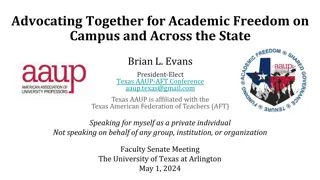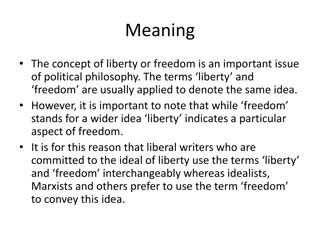Understanding Academic Freedom: Definitions, Elements, and Key Documents
Academic freedom is vital in higher education, allowing scholars to pursue knowledge without interference. This article explores various definitions of academic freedom, highlighting its focus on research, teaching, and free speech. It also delves into key documents from the AAUP that shape the understanding of academic freedom in the academic community.
Download Presentation

Please find below an Image/Link to download the presentation.
The content on the website is provided AS IS for your information and personal use only. It may not be sold, licensed, or shared on other websites without obtaining consent from the author. Download presentation by click this link. If you encounter any issues during the download, it is possible that the publisher has removed the file from their server.
E N D
Presentation Transcript
ACADEMIC FREEDOM In and Out of the Classroom
SELECTED DEFINITIONS OF ACADEMIC FREEDOM The profession s claim to academic freedom is grounded firmly in a substantive account of the purposes of higher education and in the special conditions necessary for faculty to fulfill those purposes. In essence, academic freedom consists of the freedom to pursue the scholarly profession according to the standards of that profession The core of the scholarly norm of academic freedoms is that nonacademics such as trustees and administrators should refrain from interfering with scholarship and teaching, and leave evaluation of academic quality to scholarly peers. At its core, academic freedom is the freedom of scholars to pursue the truth in a manner consistent with professional standards of inquiry. Academic freedom is the freedom of a teacher or researcher in higher education to investigate and discuss the issues in his or her academic field, and to teach or publish findings without interference from political figures, boards of trustees, donors, or other entities. Academic freedom also protects the right of a faculty member to speak freely when participating in institutional governance, as well as to speak freely as a citizen.
Elements of Academic Freedom Each of these definitions conceives of academic freedom as directly concerned with 1) research (and publication of results), and 2) teaching. The last definition (from the AAUP) also notes academic freedom encompasses 3) intramural speech ( speak freely when participating in institutional governance ) and 4) extramural speech ( speak freely as a citizen )
Key AAUP Documents Appendix I of the 1915 Declaration of Principles on Academic Freedom and Academic Tenure: https://www.aaup.org/NR/rdonlyres/A6520A9D-0A9A-47B3-B550-C006B5B224E7/0/1915Declaration.pdf 1940 Statement of Principles on Academic Freedom and Tenure (with 1970 Interpretive Comments): https://www.aaup.org/file/1940%20Statement.pdf
All of the previous definitions were of academic freedom as a professional norm The legal/constitutional notion of academic freedom is quite limited: Sweezy v. New Hampshire, 354 U.S. 234 (1957) Keyishian v. Board of Regents, 385 U.S. 589 (1967) Garcetti v. Ceballos, 574 U.S. 410 (2006)
Sweezy v. New Hampshire Decision: Reversal of a contempt conviction of a professor for refusing to answer questions from state Attorney General regarding his political memberships/associations. Holdings: Plurality decision (Warren) not centered on constitutional academic freedom, but dicta does note grave harm present when government intrudes on the intellectual life of a university. Concurring opinion (Frankfurter) more centered on academic freedom. Neither has force of law
Keyishian v. Board of Regents Decision: Strikes down loyalty oath requirement. Holding: Majority opinion (Brennan): Our Nation is deeply committed to safeguarding academic freedom, which is of transcendent value to all of us and not merely to the teachers concerned. That freedom is therefore a special concern of the First Amendment, which does not tolerate laws that cast a pall of orthodoxy over the classroom. Brennan s statement is treated as dicta, advancing the normative conception of academic freedom while grounding the decision in First Amendment analysis
Garcetti v. Ceballos Deputy district attorney Ceballos criticized his boss in an internal memorandum regarding the process by which a warrant was sought Ceballos alleged he suffered professional consequences transfer, reassignment, denied promotion as retaliation In 5-4 decision, Supreme Court declared that Free Speech does not apply when a public employee speaks within the framework of job responsibilities When writing the memo, Ceballos was not acting as a citizen, but as an employee Note that the Court seems to be implying his speech would have received greater protection if made publicly
Excerpts from Garcetti v. Ceballos Kennedy s opinion for the Court There is some argument that expression related to academic scholarship or classroom instruction implicates additional constitutional interests that are not fully accounted for by this Court s customary employee-speech jurisprudence. We need not, and for that reason do not, decide whether the analysis we conduct today would apply in the same manner to a case involving speech related to scholarship or teaching. Souter s dissent [The majority s] ostensible domain beyond the pale of the First Amendment is spacious enough to include even the teaching of a public university professor, and I have to hope that today s majority does not mean to imperil First Amendment protection of academic freedom in public colleges and universities, whose teachers necessarily speak and write pursuant to official duties.
Free Speech =/= Academic Freedom No expectation that uses of Free Speech are consistent with professional standards and, thus, false beliefs are protected Academic freedom arguments about production of knowledge have a communal element to them peer review, etc. that need not factor into Free Speech standards Academic freedom carries with it professional protections, though: Future of tenure Status of academic freedom for contingent faculty Normative claim: Academic freedom typically ought to be understood and protected according to its normative, rather than its legal, understanding
Who can claim (normative) academic freedom? 1. Individual teachers and researchers 2. Academic institutions 3. Departments, schools, and colleges within the larger institution 4. Students
1. Individual teachers and researchers Core understanding: Production and dissemination of knowledge/truth, encompassing research and teaching For several reasons, academic freedom offers broadest protections in research Research can take scholars in directions they may not go in the classroom Certain norms governing classroom activity are less/not present in research Intramural speech is less clean than the core understanding, but principles of shared governance are typically held by most institutions (allowing that details matter) Extramural speech is less settled and presents difficulties not typically faced within the core understanding
2. Academic Institutions Academic institution have significant latitude to define themselves Rooted in history: university as corporate entity protecting own interest against others Numerous policies are directly connected: Admissions Academic programs offered or not offered Organization of academic programs into colleges, schools, institutes, etc. Policies regarding assessment, evaluation, tenure, promotion, etc. Speech codes, honor statements, and other similar policies Certain aspects of the classroom setting
3. Departments, schools, and colleges within the larger institution Differing norms in terms of pedagogical approaches, what counts as a publication, how weighted, etc. Note that the common practice of having tenure/promotion recommendations (not decisions) made by a single committee after multiple layers of review demonstrates an attempt to account for academic freedom at multiple levels.
4. Students Clearly the most limited notion Student research is not as free and is almost always part of a classroom setting with standards prescribed by a faculty member Typically takes place within narrower parameters Core element concerns the classroom experience 1967 Joint Statement on Rights and Freedoms of Students: https://www.aaup.org/report/joint-statement-rights-and-freedoms-students Key academic elements concern right to take reasoned exception to views offered in any course and to be free of prejudiced or capricious academic evaluation.
Relation between Institutional and Individual Academic Freedom RESEARCH As noted, conducting research is probably the purest zone in terms of individual academic freedom Universities should not be in the business of prohibiting research or judging the results on anything other than professional standards Professional standards for evaluation research are typically those of the relevant discipline Most controversies arise when research is publicized and may fit better into discussion of extramural speech
Relation between Institutional and Individual Academic Freedom TEACHING Universities should generally be expected to defer to professional standards in terms of what content is suitable for a given class, and how it should be taught. The academic freedom of an individual professor can come into conflict with disciplinary/professional norms and standards of what is accepted knowledge in field Controversies that find their way to court are often decided along lines other than professional norms Closest precedent in PA comes from Edwards v. California University of Pennsylvania (1998), which declared that a public university professor does not have a First Amendment right to decide what will be taught in the classroom and that the First Amendment does not place restrictions on a public university s ability to control its curriculum. What???
Relation between Institutional and Individual Academic Freedom TEACHING (cont d) Cases before judges will be decided according to legal/constitutional standards In Edwards, the court asserted that the university itself is the relevant speaker for all classroom instruction The Edwards decision said nothing about the permissibility or advisability of the application of norms of academic freedom, only that there is no constitutional right to academic freedom applicable in the case Universities that are committed to academic freedom often seek to affirm this commitment for several reasons: accreditation, attracting quality faculty and students, reputation, etc. This commitment is often announced in relevant policies and documents, including, at WCU, Article 2 of the Collective Bargaining Agreement and other local agreements
Relation between Institutional and Individual Academic Freedom EXTRAMURAL SPEECH The recent controversy at the University of Florida Clear violation of the norm of academic freedom Probable First and Fourteenth Amendment violation Ingredients of response and reversal University s accreditor raises possibility of noncompliance issues Faculty publicly communicate their experience Elaboration of historical principle that public university is not a mere arm of the state Contrasting the university s actions with the language of the collectively bargained agreement
Relation between Institutional and Individual Academic Freedom EXTRAMURAL SPEECH (cont d) Compare views from left and right: https://www.chronicle.com/article/how-to-deal-with-the-dark-side-of-social-media https://www.chronicle.com/article/a-faculty-first-aid-kit-for-your-free-speech-crisis As referenced in Berube s article, here is a useful document regarding social media and extramural speech: https://sites.psu.edu/academicaffairs/files/2020/09/Social-Media-Support- and-Resources-for-Penn-State-Faculty_09-17-20.pdf
Relation between Institutional and Individual Academic Freedom INTRAMURAL SPEECH Perhaps the most theoretically unsettled (though not the most controversial) area in the aftermath of Garcetti Much of the assurance of protection comes from tenure Principles of shared governances are logically entailed by the history, structure, and purpose of most colleges and universities Still site of much debate and negotiation 1966 AAUP Statement on Government of Colleges and Universities: https://www.aaup.org/report/statement-government-colleges-and-universities























